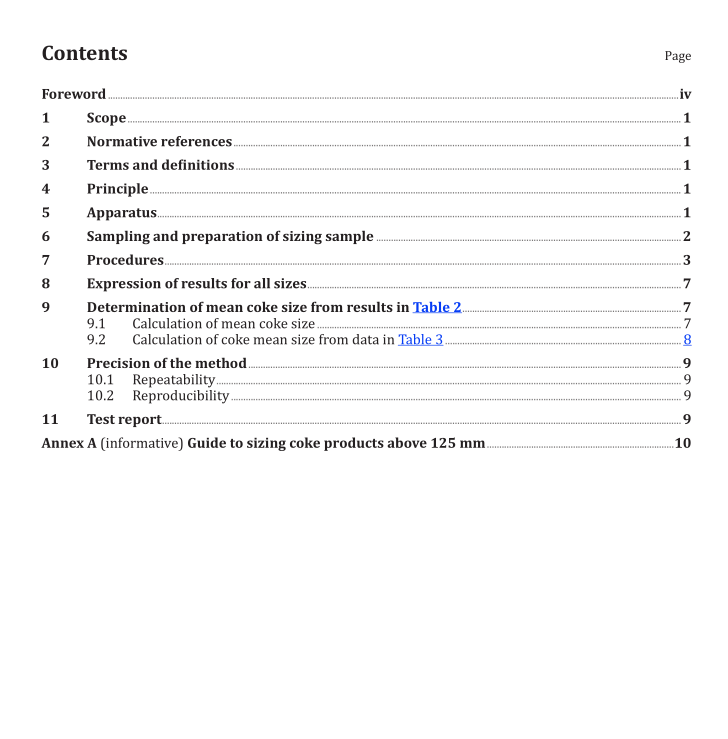ISO 728:2021 pdf download.Coke — Size analysis by sieving.
This document specifies procedures for the size analysis of coke by manual and/or low impact mechanical sieving, using square or round holed sieves of aperture sizes between 125 mm and 0,5 mm.
Guidance on handling the sampling and sizing of coke products greater than 125 mm is given in Annex A.
2 Normative references
The following documents are referred to in the text in such a way that some or all of their content constitutes requirements of this document. The latest edition of the referenced document (including any amendments) applies.
ISO 579, Coke — Determination of total moisture
ISO 1213-2, Solid mineral fuels — Vocabulary — Part 2: Terms relating to sampling, testing and analysis
ISO 3310-1, Test sieves — Technical requirements and testing — Part 1: Test sieves of metal wire cloth
ISO 3310-2, Test sieves — Technical requirements and testing — Part 2: Test sieves of perforated metal plate
ISO 13909-5, Hard coal and coke — Mechanical sampling — Part 5: Coke — Sampling from moving streams
ISO 13909-6, Hard coal and coke — Mechanical sampling — Part 6: Coke — Preparation of test samples
ISO 18283, Hard coal and coke — Manual sampling
3 Terms and definitions
For the purposes of this document, the terms and definitions given in ISO 1213-2 apply.
ISO and IEC maintain terminological databases for use in standardization at the following addresses:
— ISO Online browsing platform: available at https:// www .iso .org/ obp
— IEC Electropedia: available at http:// www .electropedia .org/
4 Principle
A sample of coke with less than 5 % moisture is subjected to a process of size analysis by a specified manual and or mechanical sieving, and the results are expressed in terms of the cumulative percentage by mass of the coke remaining on sieves of different sized openings.
5 Apparatus
5.1 Test sieves, in accordance with ISO 3310-1 and ISO 3310-2.
The set of sieves used shall have exclusively round holes or exclusively square holes. It is important to check the sieves from time to time, using the methods specified in ISO 3310-1 and ISO 3310-2, to ensure that the hole dimensions are within the specified tolerances. Worn or damaged sieves can give rise to serious errors in size analysis and shall be discarded. The test sieves should be selected according to the requirements of the test and the characteristics of the sample. If possible, the series of sieves should be selected so that the mass of coke in any size fraction does not exceed 25 % of the total mass of sample being sieved. For ungraded cokes, an example of a series of test sieves of nominal hole sizes in Table 1 are outlined. Other sieves of various nominal hole sizes can also be chosen. For samples containing pieces with a particle size greater than 125 mm, single-hole gauges may be used instead of test sieves.
5.2 Balance or scale, capable of measuring the mass of each size fraction to the nearest 0,1 %.
5.3 Receivers or bins, for collecting material passing through the sieve.
5.4 Trays, smooth, of non-corrodible material, of at least 400 mm × 400 mm, depending on the mass of sample and number of analysis required.
5.5 Lids, to fit the test sieves.
5.6 Flat brush, for cleaning the sieves and for brushing dust from the trays.
5.7 Hardwood block, about 150 mm long with a 10 mm × 10 mm cross-section, for tapping the sieve.
5.8 Shovel or scoop.
5.9 Vibratory sieve shaker for mechanical sieving, (see example Figure 2). Small low impact vibratory sieve shakers may be used, providing that their action does not break the coke and that the results are known to be not biased with respect to the results obtained by hand shaking.
6 Sampling and preparation of sizing sample
The sieving shall be carried out on samples having less than 5,0 % moisture as per the following procedures.
a) For unknown cokes, two gross samples shall be sampled in accordance with ISO 13909-5 or ISO 18283. Each gross sample shall be prepared in accordance with ISO 13909-6 or ISO 18283 and meet the minimum masses as quoted in Table 1. Prepare one of these samples for total moisture determination in accordance with ISO 579. If the total moisture is higher than 5,0 % (as sampled), dry the other sample sufficiently to reduce the total moisture content to lower than 5,0 % (as sampled). After the initial drying if the total moisture is still above 5,0 % further drying will be necessary until the sample moisture is less than 5,0 %. The final dried sample less than 5,0 % moisture is used for the test.
b) For known cokes with less than 5,0 % moisture from the same plant or same supplier, no further pre-treatment is required. If the moisture is above the 5,0 % level, the drying time to reach less than 5,0 % (as sampled) may be determined by taking the average drying time over 10 lots. Alternatively, drying most coke samples for 12 h or more at 100 °C to 200 °C should render the sample suitable for sizing only. If only size analysis is required, it is permissible to take one gross sample for sizing and use the determined period or the longer 12 h drying time at 100 °C to 200 °C to prepare the gross sample for sizing.ISO 728 pdf download.ISO 728 pdf download
